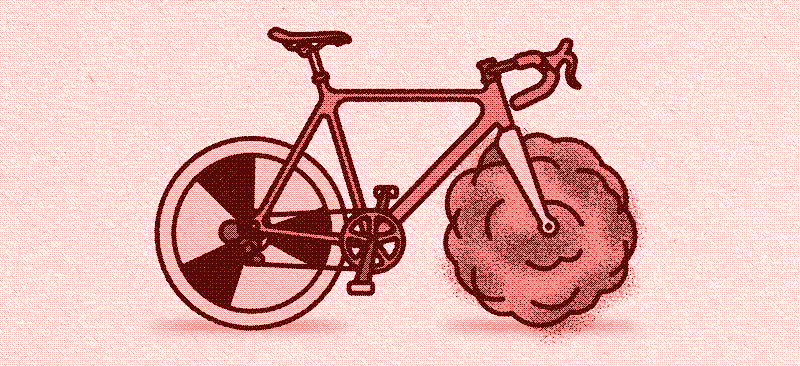- cross-posted to:
- citylife@beehaw.org
- rowerki@szmer.info
- cross-posted to:
- citylife@beehaw.org
- rowerki@szmer.info
A great read+great magazine.
TL;DR: Old bikes last way longer than new bikes. From a production standpoint, steel bikes have a smaller carbon footprint than aluminum or carbon frame bikes. Conventional bikes use fewer consumables over their usable life than electric bikes. Among electric bikes, cargo bikes use the most resources to run and maintain.
I can’t help but feel like this is thinking way too far ahead. It feels to me that society has to get people into riding bicycles as an option before even thinking about refining the processes around building bicycles. A big factor of lifecycle (heh) assessment is the amount of usage you get out of a given produced object before it becomes necessary to replace. Making the option to ride the bike easier, more accessible, more inviting is how you make bicycles more sustainable.
re: carbon fiber cargo bike emissions
Clearly there needs to be more studies because this feels like very narrow view of cargo bikes especially when the market for consumer cargo bikes is largely occupied by Urban Arrow (aluminum), Riese & Muller (aluminum), Larry vs Harry (Aluminum), and many more that construct cargo bikes out of aluminum or steel. Just looking at some commercial models of cargo bike it seems like for the most part those are made from aluminum as well. I believe that Urban Arrow offers models for businesses.edit:formatting
It feels to me that society has to get people into riding bicycles as an option before even thinking about refining the processes around building bicycles.
This is where my head is at. Although it’s good to see that these things are being assessed anyway.
i found the AI generated tldr that you originally posted to be a bit confusing, but the article itself was very interesting. Here is my summary of the major points:
- from a production standpoint, steel bikes have a smaller carbon footprint than aluminum or carbon frame bikes.
- conventional bikes use fewer consumables over their usable life than electric bikes.
- among electric bikes, cargo bikes use the most resources to run and maintain.
to simplify this from a long-time bicycle commuters perspective: steel is real 😁
I’m gonna edit the TL;DR :)
steel is real
real heavy
the real tl;dr

So the least efficient bicycle is about half that of the average car. I’ll take that. Since the lifetime miles traveled on any bike is going to be at least an order of magnitude less than the average car miles traveled, infrastructure and lifestyle changes to replace car reliance with bike reliance are hugely beneficial from the perspective of reducing carbon emissions.
Does this mean that the carbon impact of soda cans is significant?

So you just can a bike after ~12k miles? That’s insane.
I guess on average they get damaged from neglect/theft/crashed. But that seems so insane to me.
Interesting read.
I’ve always wondered about the environmental footprint of regular vs ebikes after switching to the latter a couple of years ago.
I think in my case, one point in favour of the ebike is that it has replaced more car trips? Outside of the winter months, around 80% of my trips around the city are now by ebike compared to perhaps 60% before with the traditional?
From a purely anecdotal standpoint, I do have a thirty year old steel bike that I still use to cruise around, but I do have a much newer bike for exercise and long distance. I’ve had my steel bike tuned up a couple of times over the years and all the bike shop people say it’ll basically last forever since there’s no plastic on it, which is great.
But I do agree with another poster here in saying we have to get people to know that cycles even exist first. And beyond just regular people city planners and those with the means for change. I’d love to cycle and get groceries where I live, for example, but the infrastructure is poor and dangerous, so I just drive.
Feels like it’s less cut and dry than this article suggests…
It’s weird to me to assume the lifespan of a steel frame vs aluminum when only looking at a perfectly maintained bike. A poorly maintained steel frame rusts out way faster than a poorly maintained aluminum one (does the oxide ever get past the very outer layer?), and I’m not sure anyone bothers recycling the steel bike frame but they do recycle the aluminum one. Also, we’re just looking at manufacturing, but wouldn’t a lighter aluminum bike require fewer calories to move and therefore cause less carbon emissions from the rider over the lifespan as well? Never mind they mention transportation emissions of old vs new but what about new vs new? Would a local aluminum frame be better than a Chinese steel one, especially if considering the other points I’ve raised above?
I guess the point I’m trying to make is maybe now isn’t the time to really be looking at this. Maybe get more people biking, any bike, and if it becomes a major enough form of transportation then we can worry about transitioning people from better to best.
I cannot imagine that marginal calorie burn from the 1-2 lbs difference in frame material is going to outweigh the impact of manufacturing costs and longevity of steel vs aluminum, though I do agree that these should be likey addressed after bikes have the infra and adoption sorted out. E-bikes still represent the best solution towards replacing car trips for the average person imo
Yes, plus the fewer car trips the less road/tire/brake wear and those probably make far more of a difference than whatever difference there is in different bike manufacturing.
15,000 km and only one chain replacement?
Super interesting!
I believe that until capitalism makes it sustainable, the corporation will not make it sustainable.
Yep! I’d love to see indie bicycle companies grow. (homemade bikes too but those are more complicated)
I saw this guy a few years ago that provided STLs for a 3D printed bike that anyone with the proper printer can print. It was the specialized parts that you printed, and everything else was standard parts from the hardware store. I thought that was super cool. No clue what ever happened to that project.
Huh, that’s cool.
I really hope something like that can come back. The same can be done with cars, too. Why does every single model of the same friggin brand have different headlights or steering wheel shafts or whatever? You want to tell me that we’ve come such a long way in 6 months that warranted a brand new proprietary design? No. It’s capitalism for the loss. I, for one, am tired of it. Tired of the trash this creates. Tired of the extra money we all have to spend. Tired of the extra storage space required for it all. Tired of all of it.
A few decades ago, all headlights were the same.
I love that guy!
I was talking more about the lamps themselves and less about the housing. The housing I get. For design purposes, they have to be different (also, better for the environment and for non-renewable resources). But the lamps can be the same socket and, thus, interchangeable. although, I wouldn’t complain if the housing was the same, too, but not one with the lamp. Personally, I really liked the sealed beam look, but I do understand why it wasn’t the best for the environment, and am glad we moved past. Maybe we’ll get the selective beam as a standard soon. That thing was awesome.
Ya I want selective beam!
Buy a good steel touring or crossfit bike, and it’ll outlive you (unless you get hit by a car)








